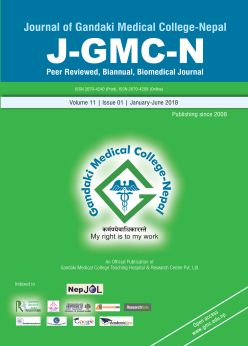Assessment of Adenosine Deaminase Level and the Utility of Polymerase Chain Reaction in Diagnosis of Tuberculous Pleural Effusion
DOI:
https://doi.org/10.3126/jgmcn.v11i1.20786Keywords:
Adenosine Deaminase, Polymerase Chain Reaction, Tubercular pleural effusionAbstract
Background: Extrapulmonary tuberculosis is one of the major causes of exudative pleural effusion. The paucibacillary nature of effusion suggests the need of markers and methodologies for accurate diagnosis and prognosis of tuberculosis as well as to differentiate it from other non-tubercular causes of pleural effusion.
Objectives: This study was focused to evaluate the utility of polymerase chain reaction (PCR) in detection of tuberculosis antigen and to assess the level of Adenosine Deaminase (ADA) in tubercular pleural effusion (TPE) and contrast it with other causes.
Methods: This is a cross-sectional study where 100 samples of pleural effusion suspected to be tuberculosis were analyzed by PCR for the detection of IS6110 segment of DNA. The level of ADA was then determined and compared in both PCR positive and negative samples. The cut-off value of ADA was >40 U/L for TPE. Student t test was applied to compare the means with statistical significance set at p<0.05.
Results: Out of 100 samples analyzed, 45% were positive for TPE and remaining 55% were non-tuberculosis pleural effusion as detected by PCR. The level of ADA was above cut-off (>40 U/L) in 43% TPE samples whereas all the non-tuberculosis effusion had ADA <40 U/L (p<0.001).
Conclusion: The ADA level was significantly higher in TPE than in non-tuberculosis cases, and PCR was able to detect suspected cases of tuberculosis effusion in almost half of the cases. This finding suggests the diagnostic utility of combined use of ADA and PCR in diagnosis of TPE.
J-GMC-N | Volume 11 | Issue 01 | January-June 2018, Page: 5-9
Downloads
Downloads
Published
How to Cite
Issue
Section
License
This license allows reusers to distribute, remix, adapt, and build upon the material in any medium or format for noncommercial purposes only, and only so long as attribution is given to the creator.

